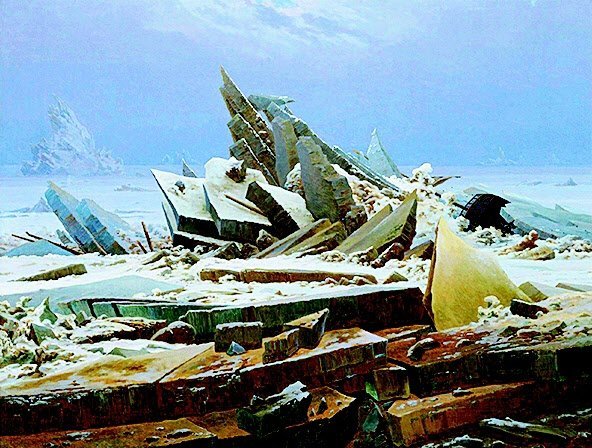Hopes in wreck, a history of success
Hopes in wreck, a history of success
Posted May. 25, 2023 07:59,
Updated May. 25, 2023 07:59

Broken pieces of ice on the cold sea are entangled with each other. A part of a wrecked ship can be seen next to a pointed piece of ice at the center. It is more than half submerged in a cold icy sea. "The Sea of Ice" (1823-1824, photo) by German painter Caspar David Friedrich (1774-1840) depicted the icy ocean in the artic. Has the artist ever been to the North Pole? How could he have painted such a wreck site?
Friedrich had never taken a long-distance ship voyage, let alone the North Pole. He traveled to mountains and prairies for sketching and was secluded at home all his life. In the winter of the early 1820s, Friedrich saw ice drifting on the Elbe River. Fascinated by the rare natural scene, he produced three sketches in oil on site. He transferred them to canvas a few years later, making the proportions and composition more dramatic. The Arctic Ice Sea theme was inspired by British explorer William Edward Parry's Arctic voyages.
Parry first explored through the Parry Strait, the entry point to the Northwest Passage, between 1819 and 1820, and in 1827, he reached the world's northernmost point for the first time in mankind and published the story as a book. In other words, Friedrich drew this surreal scene by mobilizing his imagination while referring to actual natural scenes. Even though he painted a ship that sank after colliding with ice and was broken mercilessly, the screen remains silent as if muted. It feels as if the sea has swallowed all the noise.
The painting was initially called “The Wreck of Hope.” The name was taken from a ship called “Hope” that was actually in distress. However, it is not that the artist painted with the theme of frustration. This is because the sky in the painting is getting clearer, and the sun will soon shine.
History has been made by people who take on challenges. The ship is a symbol of hope and challenge. Even if the challenge ends in failure, mankind has continued to challenge. Perhaps the artist wanted to convey that a successful history comes after numerous attempts, challenges, and failures.







